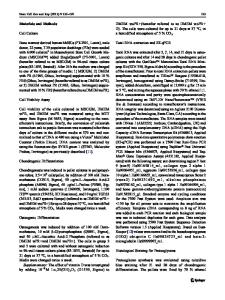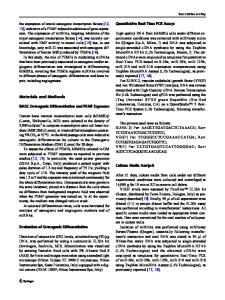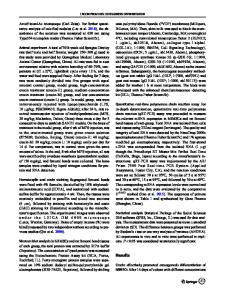Osteogenic differentiation of mesenchymal stem cells on hybrid coatings sterilized by different processes
- PDF / 807,922 Bytes
- 12 Pages / 584.957 x 782.986 pts Page_size
- 73 Downloads / 347 Views
LAPEC—Research Laboratory Corrosion, Federal University of Rio Grande do Sul (UFRGS), Porto Alegre, RS 91501-970, Brazil PGPROTEC—Postgraduate Program in Process and Technology Engineering, University of Caxias do Sul (UCS), Caxias do Sul, RS 95070-560, Brazil 3 LACOM—Laboratory of Analysis of Organic Compounds and Metals, Federal University of Rio Grande (FURG), Rio Grande, RS 96203-900, Brazil 4 IPCT—Institute for Research on Stem Cells, Federal University of Rio Grande do Sul (UFRGS), Porto Alegre, RS 90610-000, Brazil 5 Postgraduate Program in Pathology, Federal University of Health Sciences of Porto Alegre (UFCSPA), Porto Alegre, RS 90050-170, Brazil 6 Hematology and Stem Cell Laboratory, Faculty of Pharmacy, and Post Graduate Program in Physiology, Federal University of Rio Grande do Sul (UFRGS), Porto Alegre, RS 90610-000, Brazil a) Address all correspondence to this author. e-mail: [email protected] 2
Received: 7 March 2019; accepted: 11 September 2019
The objective of the present work was to evaluate the behavior of osteogenesis of mesenchymal stem cells (MSCs) on a double-layer, protective, and bioactive hybrid coating sterilized by 3 different processes: steam autoclave, hydrogen peroxide plasma, and ethylene oxide. The hybrid coating was obtained from a sol consisting of the silane precursors tetraethoxysilane (TEOS) and methyltriethoxysilane (MTES), applied on a Ti6Al4V substrate. To promote bioactivity, hydroxyapatite (HA) particles were dispersed in a second coating (bioactive layer: TEOS/MTES + HA) applied on the first (TEOS/MTES). The sterilized coatings were evaluated by scanning electron microscopy, wettability, and micrometer roughness. The behavior of hydrolytic degradation was evaluated by the mass variation of the samples and the release of silicon by the technique of highresolution atomic absorption spectrometry. All coatings presented morphological and superficial alterations after sterilization. Sterilization by ethylene oxide and hydrogen peroxide plasma intensified the hydrolytic degradation of the bioactive coating causing a greater release of silicon. The sterilized hybrid coatings did not show cytotoxicity to MSCs. Adhesion, viability, and osteogenic differentiation were favored on the sterilized coating of hydrogen peroxide plasma, which is opposite to what was observed for the ethylene oxide-sterilized coating.
Introduction With the evolution of regenerative medicine toward the development of new biomaterials that aim at the regeneration of tissues, some researchers have focused their work on the introduction of cells into structures that can serve as support for cell proliferation. The architecture of this biomaterial defines the shape of the new tissues to be formed [1]. The materials to be used for tissue engineering can be considered as a matrix for the growth of cells, tissues, and organs and thus need to provide both the physical/chemical and biological support for cell adhesion, proliferation, migration, and differentiation [2, 3]. According to Boudriot et al. [4], there
Data Loading...











